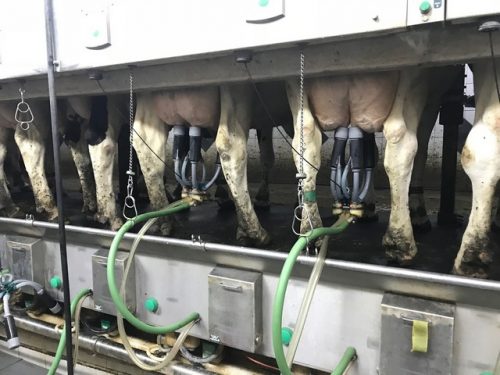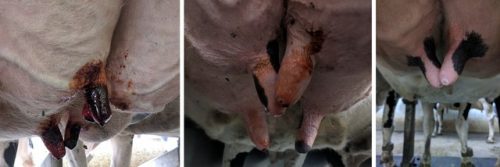Milking time labor is a large cost on any dairy farm. As today’s farms get larger and move toward parlor type operations, most discussions center around how to maximize parlor efficiency and reduce overall milking time. Regardless whether cows are milked in a parlor or tie stall, the average farm will still spend a minimum of 2-4 hours twice a day, and in some cases longer, milking their cows. Our well-managed farms have discovered that milking time can be spent on more than just milking. That time can also be used to improve Udder Health and monitor Lameness in their herd. Here are a few ideas to make the most of your Milking time:

Fore-stripping: One of the most useful practices to incorporate into the milking routine is fore-stripping. Not only does it detect abnormal milk, it also does the best job of stimulating oxytocin release from the cow’s pituitary gland. Dairies that fore-strip have cows milk faster, produce more milk, and have a lower new infection rate. Research has consistently shown that severity of clinical mastitis is approximately 50% mild, 35% moderate, and 15% severe (Pinzon-Sanchez and Ruegg, 2011, Oliveira et al., 2013). Based on this distribution, when farms do not routinely fore-strip, approximately 50% of mastitis cases go undetected. Evolving technologies have made On-Farm Culturing easier and more accurate, allowing progressive farms to use fore-stripping as a tool to pick up mild mastitis cases earlier and treat cows more appropriately based on culture results.
Post stripping: Overmilking will affect teat end health and increase the possibility of bacteria entering the teat. Periodic post stripping a group of cows can help to monitor how well your cows are being milked. This is done by hand stripping each quarter for 15 seconds once the milking unit has come off. The goal is to have 150-250 mL (½ cup – 1 cup) as a total from all 4 quarters. Uneven amounts between quarters can indicate problems with unit alignment, pulsators, or liners. If you are unable to milk out 150 mL, then take off settings should be looked at. Routine strip yield tests ensure units are being removed in a timely manner and proper adjustments can be made as needed to reach optimum udder health.

Teat end condition & dip coverage: Teat condition scoring is a valuable tool that has virtually no cost and can provide a heads-up on problems with milking machine settings, the concentration of germicidal teat dips or the cow’s environment. Research has shown that poor teat condition can reduce milk yields and increase milking times. The whole teat barrel and teat end should be closely examined, and each teat compared with other teats on the udder, as well as with those of other cows. Cows showing discomfort during milking with teat firmness and redness can be early signs of milking equipment problems. Teat-end damage may also be visible as a build-up of keratin around the teat canal. This condition is called hyperkeratosis and is usually brought on by overmilking. Hyperkeratosis is a normal physiological response to the forces applied to the teat skin during milking, either by a milking machine, or a calf. When the keratin ring becomes cracked and rough – or, in more severe cases, turns hard and black – it creates the perfect environment for contagious mastitis-causing pathogens such as Staphylococcus aureus to thrive. Hyperkeratosis indicates that there may be a problem with the milking equipment or settings. The goal of teat condition scoring should be to have less than 20% of the cows with 1 or more teats scoring rough/very rough, or be swollen and firm. The purpose of teat dip is to remove the milk film that provides a perfect meal for bacteria to feed on between milkings and leave a germicide on the teat to kill any present bacteria. It is critical to consistently and properly cover the entire area of the teat that had contact with the milking unit. Teat dip coverage should be monitored on a regular basis. Teat dip containers should also be monitored as poorly maintained containers can be contaminated.
Locomotion Scoring: Most farms use the time gathering the cows into the holding area to look for lame cows that need attention. Unfortunately, the last cows into the holding area, and easiest to spot, are already moderately lame. Although these cows need attention, farms that want to improve lameness need to be identifying the mildly lame cows that have a Locomotion Score of 2/3. Cows exiting the milking parlor can be assessed for subtle lameness that may be otherwise overlooked, as they walk down the return alley. Making this a practice the day before the hoof trimmer visit allows for farms to take care of the mildly lame cows early, allows for a better individual prognosis, and has the potential to reduce overall herd lameness.
Digital dermatitis scoring: Research has shown that routine monitoring of cows for Digital Dermatitis (DD) lesions is key in assessing the effectiveness of your footbath treatment protocol, and that clinical evaluation of the cow’s feet in a trimming chute has always been the gold standard for diagnosing, staging, and determining prevalence of DD within a herd. However, since approximately 90% of DD lesions are located on the hind feet (Murray et al., 2002; Relun et al., 2011; Solano et al., 2016), DD scoring in the milking parlor can be used as a simple tool for early detection, prompt treatment interventions, and herd monitoring. Monitoring in the parlor is also practical for the farmer and can avoid distress of the cows (Relun et al., 2011; Stokes et al., 2012; Thomsen et al., 2008).

Automatic milking systems (AMS) are becoming more popular every day. They provide greater flexibility for dairy farmers and eliminate the need to milk cows at regular set times. This new-found freedom does not mean that the progressive farmer spends any less time in the barn, or that udder health is any less important. Robotic dairy farmers need to be more creative when it comes to monitoring. Time when the cows are locked up for Herd Health can provide an opportunity to assess digital dermatitis lesions and even teat end condition of the herd. Spending time analyzing computer health reports and watching the robot milk cows can be provide insight into how well cows are being milked out. Teat dip coverage and teat condition is extremely important in robot herds. Cows chose to be milked at random times throughout the day and often go directly to lie down after milking which may not allow enough time for the teat canal to close.
Many of these tips are easy to implement on your farm today to make the most of your farms milking time. Remember your herd veterinarian as a resource to provide help when problems arise.
This article was featured in our Fall 2018 issue. Written by Dr. Lisa Hemphill, BC
